Physical Address
304 North Cardinal St.
Dorchester Center, MA 02124
Continence is determined by the balance between forces that maintain urethral closure and those that affect detrusor function. Parasympathetic nervous system activity via the neurotransmitter acetylcholine stimulates receptors in the bladder wall to activate detrusor contraction. Sympathetic nervous system activation leads to bladder relaxation. Nearly 50% of all women may suffer from some degree of urinary incontinence during their lifetime. Being obese or overweight increases the risk of urinary incontinence, and weight loss can reduce stress and urge incontinence.
Approximately 20% of women with urinary incontinence suffer from detrusor overactivity. Behavioral changes and oral medications are first-line treatments, although often they have disappointing cure rates. Neuromodulation and surgical procedures are available and effective for refractory symptoms.
The midurethral synthetic tape slings appear to have similar efficacy for the surgical treatment of stress incontinence, with a shorter surgery and recovery time than a Burch colposuspension. Retropubic and transobturator midurethral slings have similar success rates for stress incontinence, although with different risk profiles. The retropubic approach has a significantly higher risk of bladder perforation, bleeding, and voiding dysfunction, and the obturator approach has a higher risk of groin and leg pain.
Approximately 50% of all women will develop urinary infections at some point in their lifetime, and by age 70 years, as many as 10% of women will have recurrent urinary tract infections.
Painful bladder syndrome–interstitial cystitis is a painful, chronic bladder condition that is not related to infection and is associated with symptoms of bladder and pelvic pain, urinary frequency, urgency, or nocturia, and often dyspareunia.
A 48-year-old woman, gravida 2, para 2 (G2P2) and otherwise healthy, reports poorly defined perineal dampness, pelvic pain, and urinary frequency. Which provider does she make an appointment to see? Lower urinary tract complaints are very common in women, and their presentation is often similar to gynecologic disorders, present concurrently with gynecologic disorders, and occasionally are a result of gynecologic procedures. The provider that the majority of women with lower urinary tract disorders see first for evaluation of their symptoms is their gynecologist. There is considerable overlap in symptoms with urinary tract infections, overactive bladder, endometriosis, dyspareunia, and bladder pain syndrome, so the gynecologist should be familiar with these conditions. This chapter will review the anatomy and physiology, as well as the evaluation and treatment, of some of the more common disorders of the female lower urinary tract.
The normal lower urinary tract has two functions: the storage of urine at low bladder pressures without leakage; and the voluntary and complete emptying of urine from the bladder. These functions are achieved through complex anatomic, physiologic, and neurologic interactions. Much of our current understanding is obtained from animal models; the relevance to human physiology is not always clear, and opinions differ.
In review, the central nervous system (CNS) consists of the brain and the spinal cord, with the peripheral nervous system (PNS) divided into the somatic and autonomic nervous systems, which are made up of afferent (sensory) and efferent (motor) neurons that communicate with the CNS. The somatic system regulates structures that are under voluntary control, such as the striated external urethral sphincter and levator ani muscles. The autonomic system regulates visceral functions such as detrusor (bladder muscle) contraction and relaxation. The autonomic system consists of the parasympathetic system (cranial and sacral segments of the spinal cord) and the sympathetic system (thoracic and lumbar segments) ( ) ( Fig. 21.1 ).
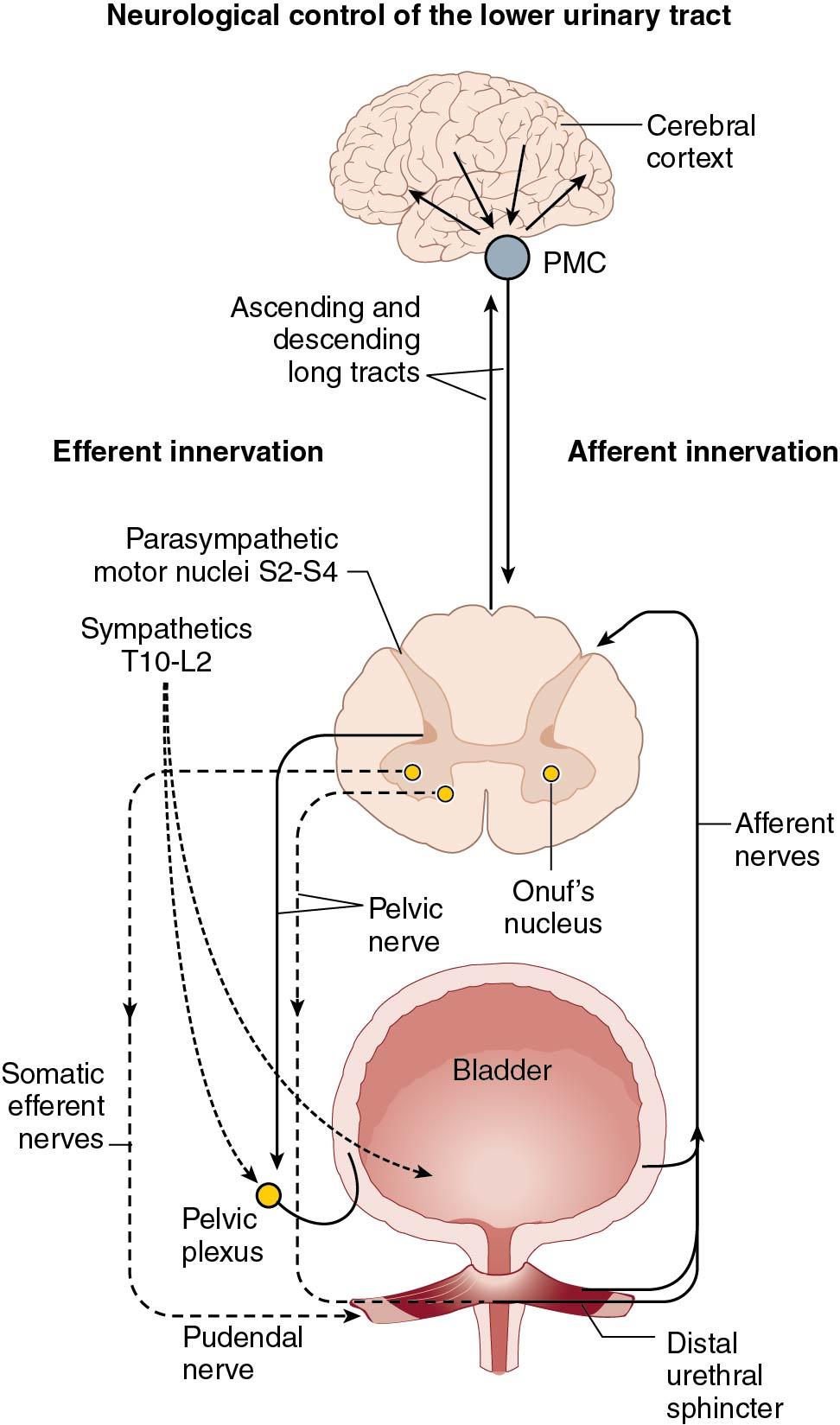
During storage, bladder pressures rise slowly despite large increases in volume. Bladder filling activates afferent nerve fibers in the bladder wall, which results in stimulation of sympathetic efferent activity in the hypogastric nerve, which leads to contraction of the smooth muscles in the bladder base and proximal urethra as well as relaxation of the detrusor from activation of beta-adrenergic receptors in the bladder wall. After a certain bladder pressure is reached, there is a gradual increase in somatic efferent nerve activity through the pudendal nerve and possibly the pelvic nerve, which causes increased activity in the striated external urethral sphincter. These are spinal reflexes located in the lumbosacral spinal cord and promote continence. At the same time, the sympathetic system inhibits parasympathetic activity at the ganglia level, further promoting bladder relaxation. The result of all these actions is filling of the bladder with low pressures without any active bladder contractions ( Fig. 21.2 ).
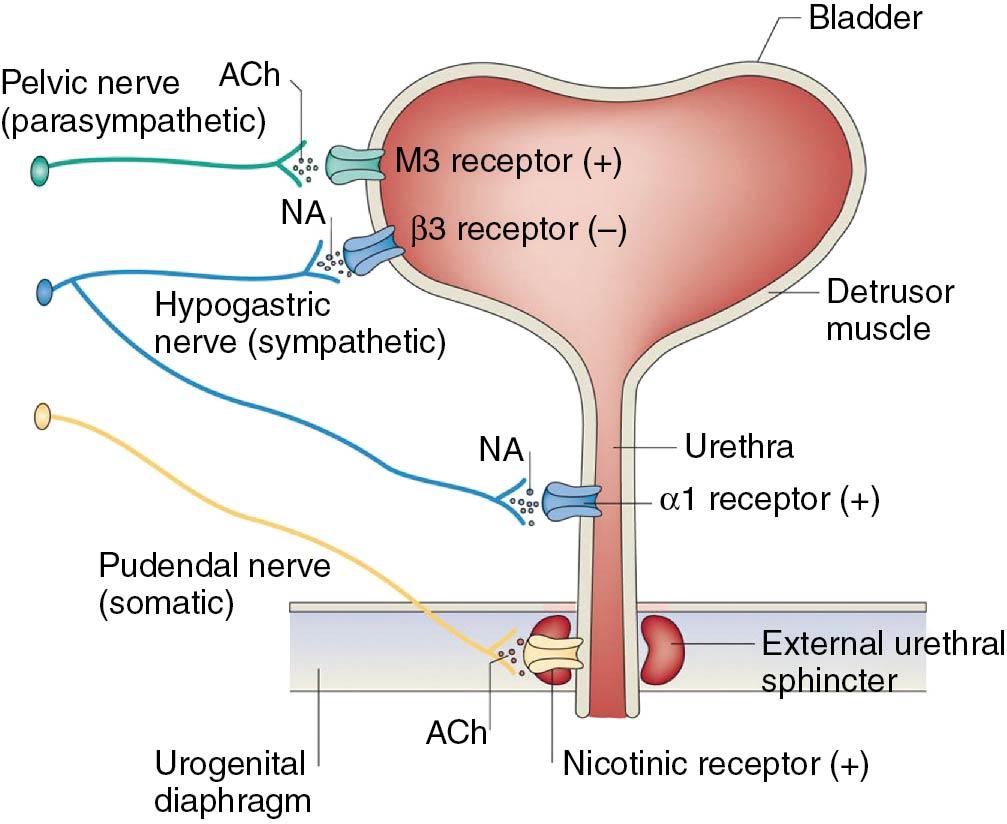
Voiding depends on the coordinated activity of the bladder outlet (external sphincter, proximal urethra/bladder base) and detrusor muscle. Bladder emptying is initiated voluntarily by signals from the cerebral cortex, which are a result of intravesicle pressure producing the sensation of distention. The first step in emptying is inhibition of somatic efferent activity, resulting in relaxation of the striated external urethral sphincter. This is closely followed by a detrusor contraction, as a result of inhibition of sympathetic efferent activity with concomitant activation of parasympathetic outflow through the pelvic nerve to the bladder and urethra. Bladder contraction is mediated via muscarinic receptors in the bladder wall. Superimposed on these autonomic and somatic reflexes are complex supraspinal (the midbrain, cerebellum, and cerebral cortex) inputs mediated through the pons (spinobulbospinal reflex), which allows for full conscious control of voiding and maintenance of the reflex until the bladder is empty ( Table 21.1 , Fig. 21.3 ).
| Loop | Origin | Termination | Function | Associated Conditions |
|---|---|---|---|---|
| I | Frontal lobe | Brainstem | Coordinates volitional control of micturition | Parkinson disease, brain tumors, trauma, micturition |
| II | Brainstem Bladder wall |
Brainstem | Detrusor muscle contraction to empty bladder | Spinal cord trauma, multiple sclerosis (MS), spinal cord tumors, neuropathy, local urinary tract disease |
| III | Sensory afferents of tumors, diabetic detrusor muscle disease | Striated muscle of urethral sphincter via pudendal motor neurons and sacral micturition center | Allows relaxation of urethral sphincter in synchrony with detrusor contraction | MS, spinal cord trauma or neuropathy, local urinary tract |
| IV | Frontal lobe | Pudendal nucleus | Volitional control of striated external urethral sphincter | Cerebral or spinal trauma or tumor, MS, cerebrovascular disease, lower urinary tract disease |
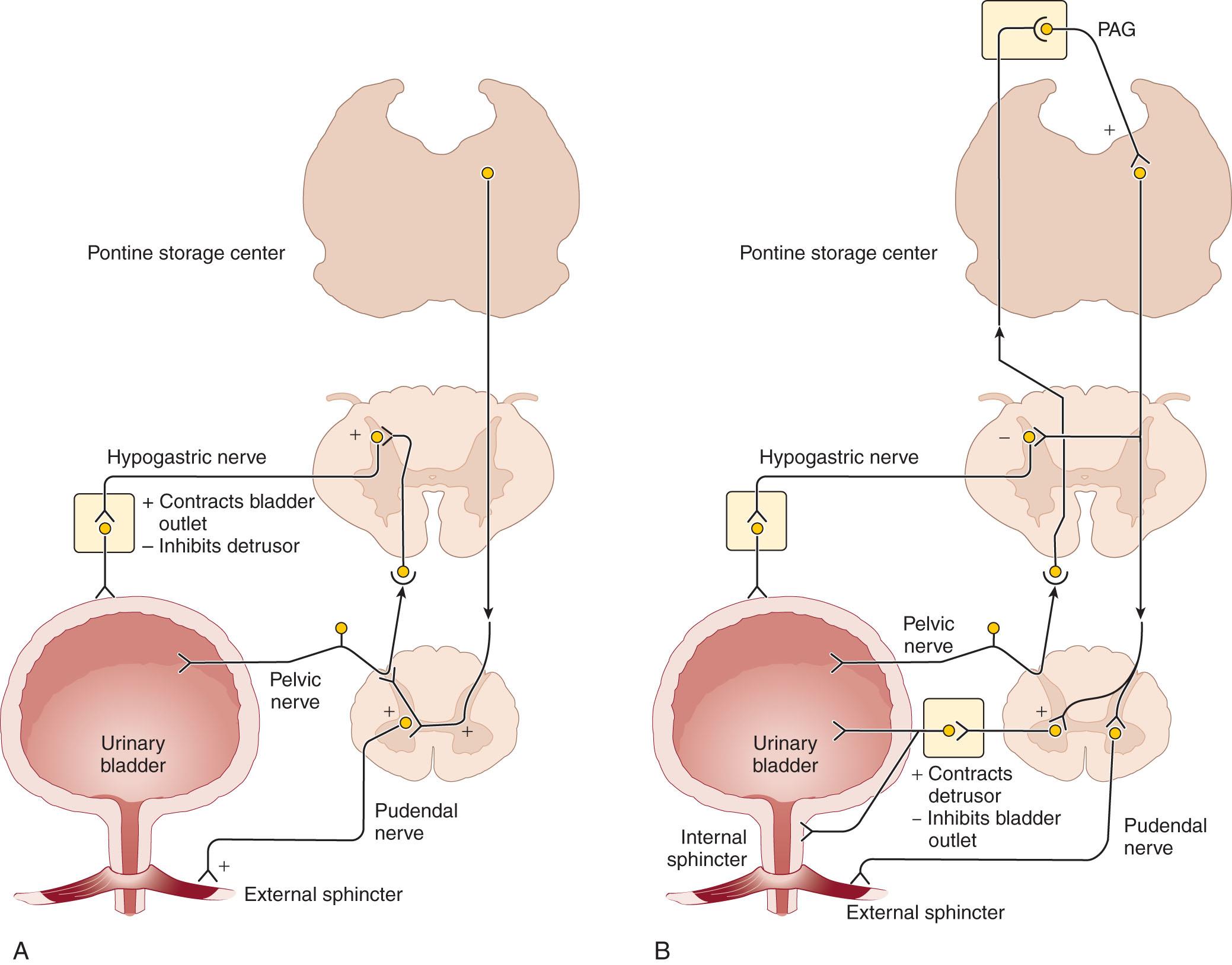
Acetylcholine (Ach) is released from postganglionic parasympathetic neurons, preganglionic autonomic neurons, and somatic neurons. There are two main types of cholinergic receptors-nicotinic and muscarinic. Nicotinic receptors have little role in the lower urinary tract. The five muscarinic receptors (M1 to M5) play a significant role, with the M2-M3 most abundant in the detrusor. M3 receptors are responsible for bladder contraction. Norepinephrine and epinephrine released from postganglionic sympathetic neurons bind to adrenergic (alpha and beta) receptors. There are multiple adrenergic receptor subtypes. The alpha 1A subtype predominates in the urethra, where it plays a role in bladder outlet contraction. Beta 2 and 3 receptors cause detrusor relaxation. Location of these receptors plays a role in function as well. Parasympathetic activation via M3 muscarinic receptors located more densely in the bladder body than base results in detrusor contraction and voiding. Sympathetic activation via alpha-adrenergic receptors in the bladder base and urethra (contraction) and beta-adrenergic receptors in the bladder body (relaxation) result in storage (see Fig. 21.2 ).
Multiple other neurotransmitters and receptors have been found in the lower urinary tract. These include adenosine triphosphate (ATP), nitric oxide (NO), vanilloids, substance P, prostanoids, and estrogen. The roles of most of these have not been defined. Many drugs affect these receptors and therefore lower urinary tract function ( Table 21.2 ).
| Classification | Examples | Pharmacologic Action |
|---|---|---|
| Anticholinergic agents | Atropine | Inhibit muscarinic receptors, thus reducing the response to cholinergic stimulation; used to reduce pressure during bladder filling and for the treatment of unstable bladder contractions. |
| Glycopyrrolate | ||
| Oxybutynin | ||
| Propantheline | ||
| Tolterodine | ||
| Smooth muscle relaxants | Dicyclomine | Direct smooth muscle relaxation reduces intravesical pressure during filling and reduces severity and presence of unstable bladder contractions; most of these agents have some degree of anticholinergic action. |
| Flavoxate | ||
| Calcium antagonists | Diltiazem | Used in the treatment of unstable bladder contractions to reduce the magnitude of the spikes by reducing the entrance of calcium during an action potential. |
| Nifedipine | ||
| Verapamil | ||
| Potassium channel openers | Cromakalim | Act to increase the membrane potential and thus reduce the myogenic initiation of unstable bladder contractions. |
| Pinacidil | ||
| Prostaglandin synthesis inhibitors | Flurbiprofen | Prostaglandins have been implicated in increased smooth muscle tone and in the induction of spontaneous activity. Inhibition of prostaglandin synthesis could promote relaxation of the bladder during filling and decrease spontaneous activity of the bladder. |
| β-Adrenergic agonists | Isoproterenol | Stimulation of β receptors induces relaxation of the bladder body, resulting in a decrease in intravesical pressure during filling. |
| Terbutaline | ||
| Tricyclic antidepressants | Amitriptyline | These agents have anticholinergic, direct smooth muscle relaxant, and norepinephrine reuptake inhibition properties. |
| Imipramine | ||
| α-Adrenergic agonists | Ephedrine | Increase urethral tone and closure pressure by direct stimulation of α-adrenergic receptors. |
| Phenylpropanolamine | ||
| Midodrine | ||
| Pseudoephedrine | ||
| Afferent nerve inhibitors | DMSO | Reduce the sensory input from bladder and thereby increase bladder capacity and reduce detrusor overactivity. |
| Capsaicin | ||
| Resiniferatoxin | ||
| Estrogen | Estradiol | Direct application to the vagina or oral therapy may increase the thickness of the urothelial mucosa, making a better seal and reducing the incidence of incontinence. Other actions may include increasing adrenergic effects on the urethra and increasing blood flow. |
In light of the complexity and extensive involvement of the nervous system, a host of systemic disease processes, including neurologic disease, and direct trauma, in addition to medications, can affect lower urinary tract function. Diabetes can result in sensory neuropathy with resultant bladder overdistention and detrusor injury with resultant urinary retention. Detrusor overactivity or involuntary detrusor contractions is commonly seen in patients with diabetes as well. Processes involving the brain and CNS such as stroke or traumatic brain injury often result in loss of bladder inhibition with detrusor overactivity as a result. Obviously a spinal cord injury with disruption of the spinal neural pathways will result in change in bladder function; what change is seen depends on the level of injury, degree of injury (partial vs. complete), and age of the injury. Approximately 15% of patients with multiple sclerosis will have a voiding complaint as their first reported symptom. Pelvic surgery with direct injury to pelvic or pudendal nerves can cause dysfunction. Pelvic nerve injury with resultant urinary retention is a known complication of radical hysterectomy.
In summary, normal bladder function requires the bladder to accommodate increasing volumes of urine at low pressure with appropriate sensation and no involuntary contractions. The bladder outlet has to be closed at rest and stay closed with increase in intraabdominal pressures. The bladder must then contract in a coordinated manner of adequate strength as the bladder outlet resistance at the level of the smooth muscle sphincter and striated sphincter lowers. This requires intact local and spinal reflexes and an intact CNS.
The bladder consists of the bladder body—the bladder above the ureteral orifices—and a bladder base consisting of the trigone and bladder neck. The bladder neck, urethra, and pelvic floor musculature make up the bladder outlet ( Fig. 21.4 , A). The bladder body and base includes a multilayered epithelium that is in contact with urine, including the following:
Lamina propria with a diffuse plexus of unmyelinated nerve fibers making contact and regulating interactions between urothelium
Detrusor smooth muscle and the wall made up of smooth muscle arranged in random directions, collagen, and elastin, resulting in the viscoelastic properties of the bladder.

These properties contribute to a low-pressure reservoir, which is needed for continence.
The continence mechanism in women centers on the proximal urethra and urethrovesical junction. Continence is maintained by multiple structural and physiologic mechanisms that promote a low-pressure reservoir and higher than storage pressure outlet, regulate closure of the urethra, and support of the bladder and urethrovesical junction. Actual closure of the urethra is produced by the involuntary internal sphincter at the bladder neck, the voluntary external sphincter muscles of the urethra, and mucosal coaptation produced by the urethral submucosal vascular plexus and anatomic attachments of the urethra and anterior vagina (hammock hypothesis).
The internal sphincter is formed by a ring of involuntary smooth muscle from the bladder trigone and 2 u -shaped loops from the detrusor. Unlike the male internal sphincter, it is fairly common for the female internal sphincter or bladder neck to be incompetent but still continent. The bulk of the muscle responsible for sphincteric control in women is the external sphincter—the circular striated muscles located in the proximal urethra and midurethra. These muscles create a nearly complete circumferential compression of the midurethra under the influence of tonic pudendal (sympathetic) innervation. Pudendal nerve injury as a result of prolonged labor with resultant sphincteric weakness is one way incontinence may occur after vaginal childbirth.
The submucosal arteriovenous complex of the urethra plays a significant role in female continence as well. It has been estimated to contribute 30% of the forces responsible for continence as a result of the seal of mucosal folds supported by the spongy nature of this estrogen rich plexus. This plexus is thicker walled and less elastic in older women, which likely contributes to lower urethral pressures and greater risk of incontinence ( Fig. 21.4 , B).
Musculofascial support for the urethra is also important for continence. Attachment of the midurethra anteriorly to the symphysis by the pubourethral ligaments and laterally to the arcus tendineus by the urethropelvic ligaments helps prevent transmission of intraabdominal pressure to the remainder of the urethra. The anterior vaginal wall, when intact, provides posterior support and compression of the midurethra, particularly with increased intraabdominal pressure.
The zone with the highest pressure in the urethra is approximately at the midpoint of the functional urethral length. The anatomic urethral length is approximately 3 to 4 cm. This high-pressure zone is located approximately 0.5 cm proximal to the urogenital diaphragm. Most of the functional urethral length is actually above the urogenital diaphragm ( Fig. 21.5 ). The submucosal cavernous plexus of vessels, the bulk of the smooth and striated muscle, and the bulk of the autonomic nerve supply are most prominent in the area in which they record the maximum urethral pressure.
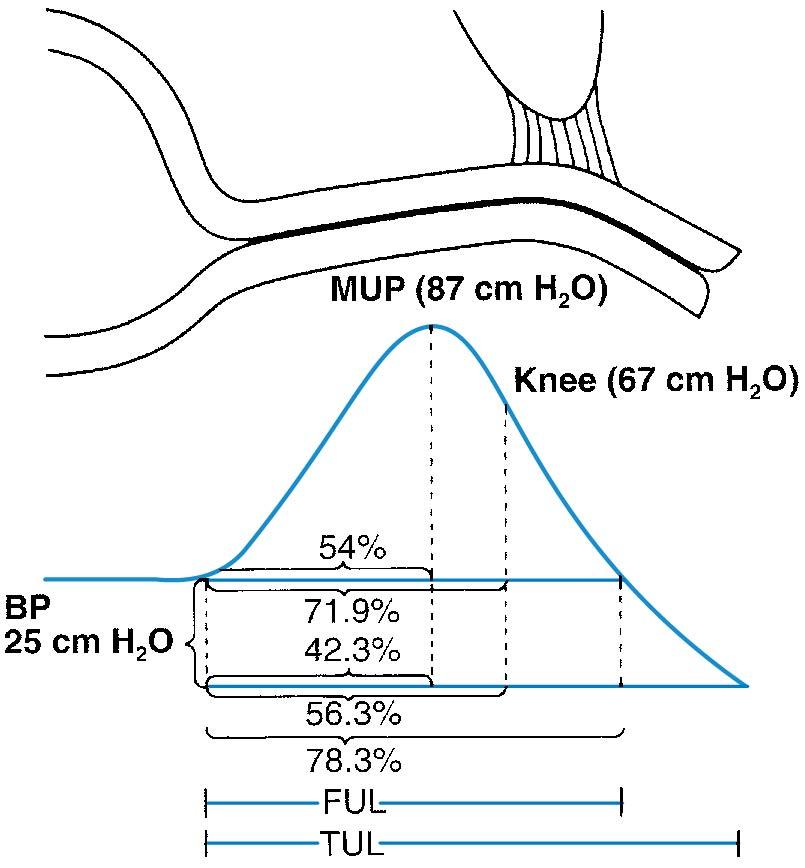
The combined effect of these anatomic attachments ( Fig. 21.6 ), urethral attributes, and muscular and neurologic functions promote continence, and the loss of any one, though often there is loss of several, can result in female urinary incontinence.
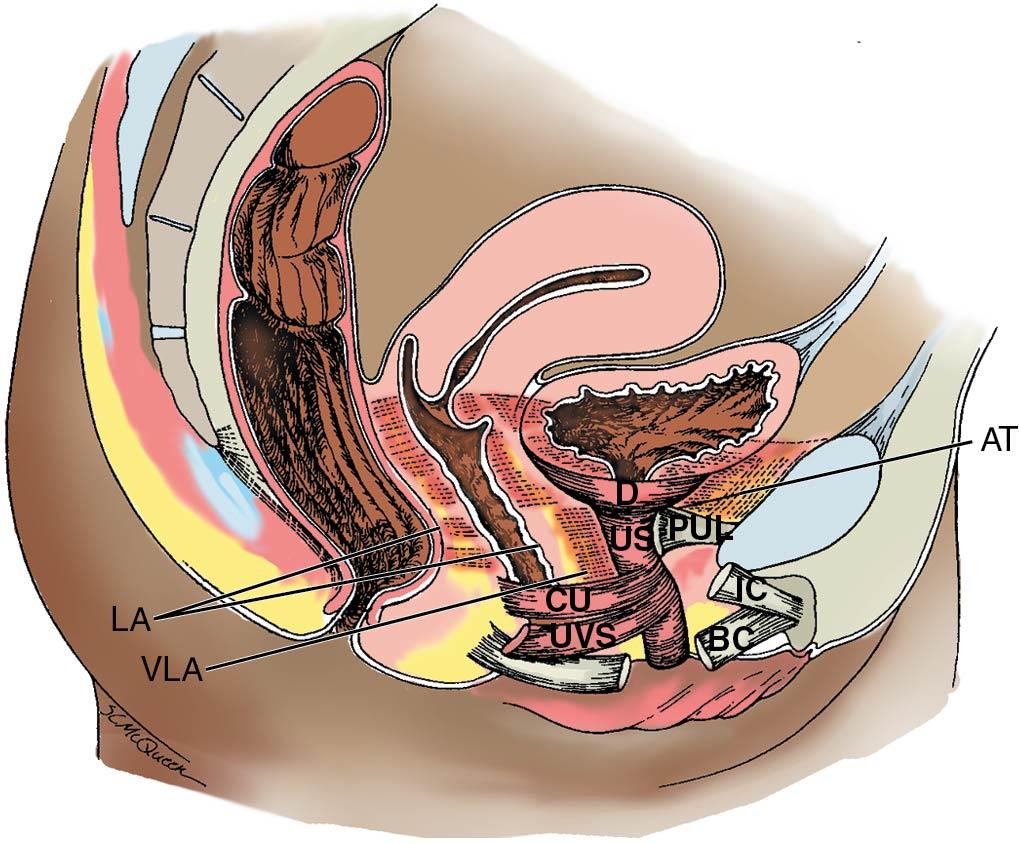
The clinical history is very useful in the diagnosis of urinary incontinence. A history consistent with urge-associated urinary incontinence—”I get an urge to go and I can’t get to the bathroom on time”—is more sensitive than urodynamics for making such a diagnosis. Several validated scales are available, such as the Urogenital Distress Inventory (UDI), Incontinence Impact Questionnaire (IIQ), Bristol Female Lower Urinary Tract Questionnaire, and King’s Health Questionnaire, although not one has become the preferred instrument. Useful testing can be done in the gynecologist’s office without the need for sophisticated equipment. These procedures are described and their benefits noted. The description is followed by a discussion of more sophisticated diagnostic techniques requiring specialized equipment.
A simple urinalysis and urine culture may provide much information. The presence of white or red blood cells (RBCs) and bacteria in a catheterized or clean voided sample, in which the perineum around the urethra has been appropriately prepared with an antiseptic solution, may suggest a urinary tract infection (UTI), nephrolithiasis, kidney disease, or even urinary tract malignancy in rare cases. UTI may be associated with urgency, frequency, dysuria, suprapubic pain, and even incontinence. In such cases the urinalysis and urine culture may be diagnostic. Several dipstick methods are available to detect bacteriuria, pyuria, and the presence of nitrites and leukocyte esterase. The accuracy of these methods is variable, but they do have some use in screening patients who are incontinent or have symptoms suggestive of infection. In some cases, a culture should be obtained to identify the specific organism involved and verify the presence of an infection. Urinalysis is also useful to screen for microscopic hematuria (RBCs) in women with new-onset urgency and frequency because underlying pathologic conditions of the urinary tract may be present. A formal microscopic urinalysis should be carried out to confirm screening results because urine dipstick tests can often yield a false-positive result (such as a urine dipstick test positive for occult blood), and actual RBCs need to be identified microscopically before proceeding with a hematuria workup or urologic referral. A catheterized specimen should be obtained if abnormal results are questioned because of vaginal contamination. This is common in women with pelvic organ prolapse, obesity, postmenopausal bleeding, or menses or in older women with arthritis and poor hand function. With a goal of limiting unnecessary use of antibiotics and thus antibiotic resistance, routine treatment of bacteruria without symptoms even in patients with diabetes is no longer recommended except for pregnant women and women planning to undergo urologic procedures.
Postvoid residual (PVR) testing is a simple procedure can be extremely helpful in the evaluation of a woman with incontinence with pelvic organ prolapse, voiding symptoms such as frequency or incomplete bladder emptying, or recurrent UTIs. The woman with a full bladder is asked to void. Then within 10 to 15 minutes the residual urine in her bladder is measured either by inserting a catheter into the bladder (after which the urine collected may be sent for urinalysis and culture if needed) or noninvasively by using ultrasound or bladder scan ultrasound. The bladder ultrasound scan devices can occasionally result in false positives because of other pelvic conditions like ascites, a large ovarian cyst, or uterine fibroids. Confirmation is necessary with catheterization if this is suspected. Definitions of normal PVR volumes vary, but under normal circumstances the amount of residual urine should be less than 20% of the total bladder volume (e.g., 100 mL after voiding 400 mL). Postoperative patients have an 85% chance of avoiding retention if their initial postoperative PVR is a third of their total volume. A large PVR suggests urinary retention resulting from inadequate bladder emptying as a result of detrusor underactivity, bladder outlet obstruction, or a combination of the two.
In many cases, stress and urge urinary incontinence can be correctly diagnosed from the clinical history alone. The bladder diary appears to be a cost-effective adjunct to clinical history for diagnosing overactive bladder. Asking the woman to complete a bladder diary is a simple, inexpensive way to obtain information about her fluid intake, voiding habits, voided volumes, and incontinence episodes. An example diary form is shown in Fig. 21.7 .
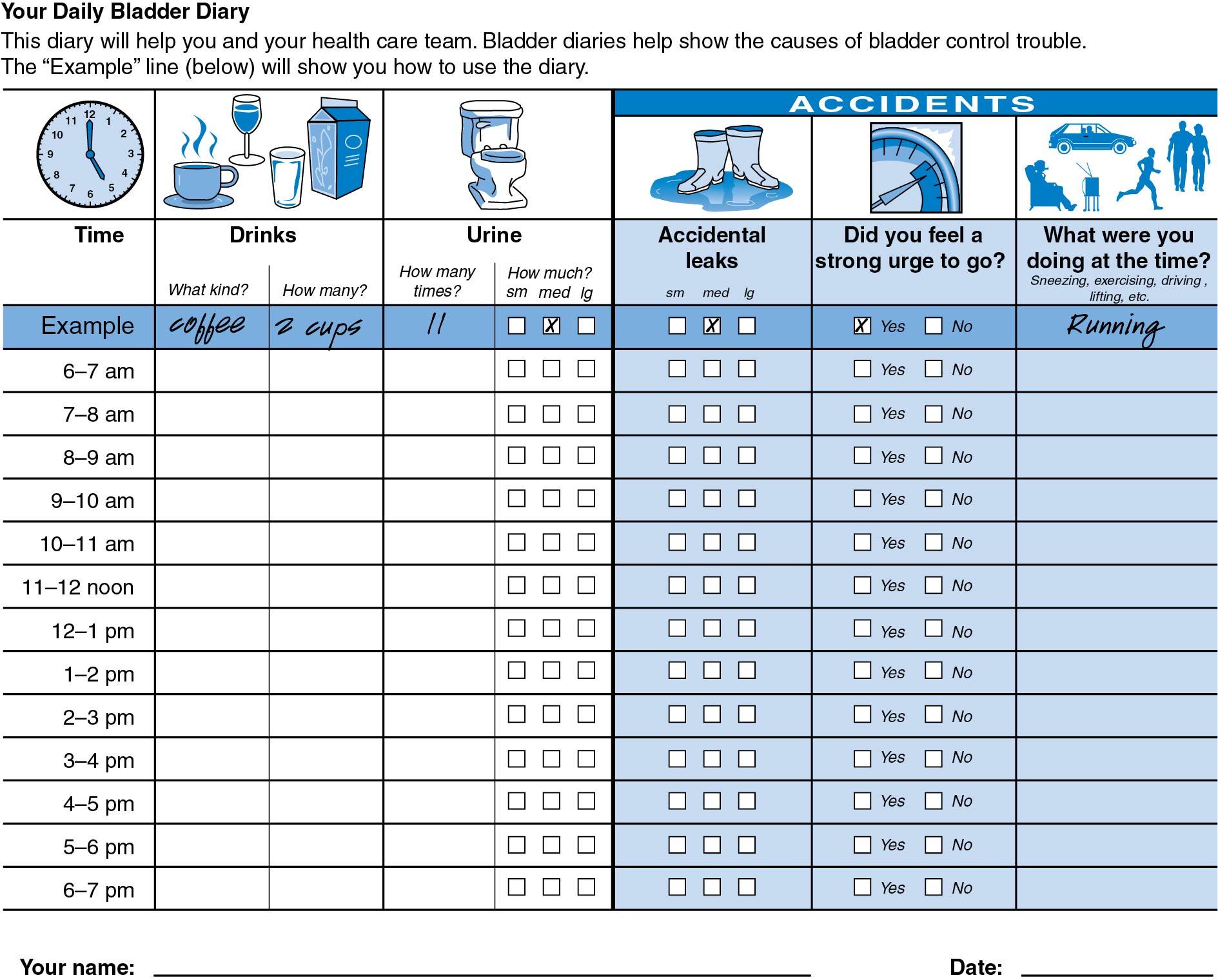
It is possible to gain a great deal of information about bladder capacity and bladder function with relatively simple tools. Once a catheter is inserted to check for residual urine, the catheter is left in place and attached to a graduated Asepto syringe without a bulb. It is possible to pour sterile saline (or sterile water) into the syringe by gravity and measure the amount of saline that first causes the woman to have the urge to void. This first urge should normally occur after 150 to 200 mL of saline has been infused. Women with normal bladder function should be able to continue to maintain continence at that level. Similarly, a strong, normally controllable urge to void usually occurs when 400 to 500 mL has been instilled. Thus a normal bladder first transmits an urge to void at 150 to 200 mL, and functional capacity is reached at 400 to 600 mL. Larger volumes can be reached without incontinence, but this is usually accomplished with a great deal of conscious effort. If, during filling, the woman reports urgency and the column of fluid in the Asepto syringe rises, leakage may be seen around the catheter and detrusor overactivity confirmed.
If a bladder has been previously filled to measure capacity, it should then be emptied to approximately 250 to 300 mL of saline, or if the bladder is empty, 250 to 300 mL of saline should be instilled. The catheter is then removed and the woman is asked to cough while in the recumbent position. If urine spurts from the urethral meatus, stress incontinence may be present and a positive cough stress test (CST) is noted. The CST should be repeated with the woman standing if no leakage is seen recumbent. Often she will appear to be continent with stress while lying down but may demonstrate incontinence when the influence of gravity on the pelvic organs is brought into play in the standing position. For research studies, 250 or 300 mL of saline is instilled, the woman is asked to cough 10 times, and any leakage is considered a positive CST. In clinical practice, if the patient has a comfortably full bladder, it is also reasonable to perform the standing CST and then calculate the volume in the bladder afterward by adding the voided volume and the PVR. If around 250 mL, the volume was adequate. If the volume in the bladder was low during a negative CST, it should be repeated with around 250 mL. The clinical stress test is effective in diagnosing stress incontinence.
Because urine loss with cough should be immediate if stress incontinence is the problem, it may be possible to detect evidence of detrusor overactivity by observing the time of the spurt of urine in the stress test. Typically the detrusor reacts a few seconds after the stimulus; therefore a spurt that occurs after a delay after a cough suggests the presence of a cough-induced involuntary detrusor contraction.
If no leakage is seen and anterior vaginal wall prolapse is present, occult stress incontinence is possible. It can be challenging to determine whether a woman with anterior vaginal wall relaxation is likely to develop overt stress incontinence after a pelvic organ prolapse repair. The CST can be repeated with the prolapse reduced with lubricated procto swabs or with a pessary. A positive prolapse reduction CST is associated with increased risk of de novo stress incontinence compared with a negative test, but it is not a perfectly accurate predictor.
A 1-hour pad weight test is another research tool for documenting pre- and postintervention urinary leakage volumes. Again, with a 250-mL bladder volume, a pad is given to the woman and she is asked to complete a series of activities over the hour, including walking, climbing stairs, coughing, and other events. If the pad weighs more than 2 to 3 g, the test is considered positive. Both this test and the CST are commonly used as objective measures of outcome for surgical incontinence trials.
Thus with urinalysis, urine culture, measuring PVR urine, bladder diary, documented first urge to void, bladder capacity, and the CST, the physician will have a great deal of information concerning the cause of the woman’s urinary complaints. More sophisticated urodynamic evaluations should be performed when these tests do not reveal an accurate diagnosis and further information is needed for treatment. A short discussion of these procedures and the equipment involved follows.
Urodynamic investigation attempts to measure bladder and urethral function and voiding function. Cystometry, part of the urodynamic test, measures the pressure/volume relationship of the bladder during the filling (storage) phase of the micturition cycle. Bladder sensations, first urge to void, normal desire to void, bladder pain, strong urge, and bladder capacity are noted. The woman can cough and perform the Valsalva maneuver to detect stress incontinence in the absence of a detrusor contraction. Detrusor overactivity may be noted with the symptom of urgency, with or without leakage, in association with a detrusor pressure rise. Poor compliance from a nonelastic bladder is noted with a gradual pressure rise of more than 15 cm H 2 O from baseline rather than phasic contractions of detrusor overactivity. Pressure flow studies measure the relationship between pressure in the bladder and urine flow rate during voiding. The ideal means of evaluating a woman for incontinence is to use a multichannel recorder that permits pressure determinations at two points within the urethra (proximal and midpoint to distal), one within the bladder, and one intraabdominally as recorded by an intrarectal sensor or by a sensor within the vagina if the vagina is in a relatively normal position (not prolapsed). Fig. 21.8 , A, shows a multichannel urodynamic study during the pressure/flow or voiding phase and highlights a woman with a voiding disorder, which was the main reason the study was ordered.
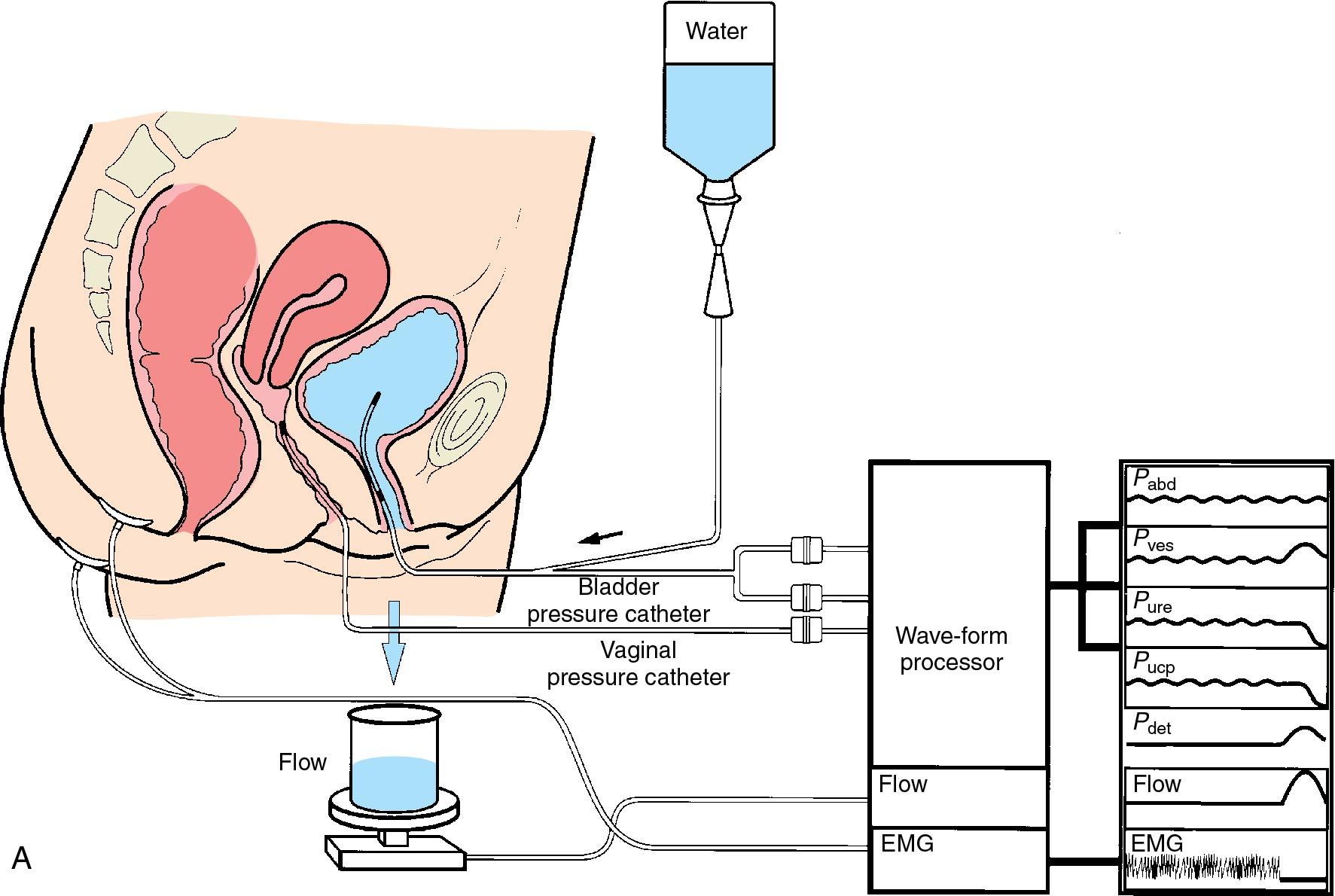
Several authors have described the concept of leak point pressure tests for evaluating urethral function in stress incontinence. The International Continence Society defines an abdominal leak point pressure (ALPP) as the lowest of the intentional or actively increased intravesical pressure that provokes urinary leakage in the absence of a detrusor contraction. This test measures urethral function or outlet competence. Increased pressure from Valsalva or cough maneuvers are called the Valsalva leak point pressure (VLPP) and cough leak point pressure (CLPP). The ALPP has been used to separate urinary stress incontinence as related to either an anatomic defect (hypermobility of the urethra) or an intrinsic sphincter deficiency; however, it has become clear there is significant overlap in these conditions and using a cutoff of less than 60 cm H 2 O to define intrinsic sphincter deficiency is too simplistic. The woman’s history and clinical picture must be considered carefully, not just an arbitrary cutoff point.
Maximal urethral closure pressure (MUCP) is another measure of urethral function in stress incontinence. MUCP is the maximum difference between the urethral pressure and the intravesical pressure. Less than 20 cm H 2 O is the criteria used to define intrinsic sphincter deficiency. Using the MUCP for choosing therapy in subtypes of stress incontinence or for outcome results in surgical trials has been criticized because, unlike the VLPP, the test is not performed during stress. A 2010 randomized controlled trial by Nager and colleagues studied the relationship between various measurements of urethral function and subjective scores of urinary incontinence ( ). They found that VLPP and MUCP have moderate correlation with each other, but each had little or no correlation with the woman’s subjective scores of incontinence severity or objective tests such as the supine empty bladder stress test. These data call into question the use of urodynamic measures of urethral function when they do not correlate with urinary incontinence severity; however, many stress incontinence surgical trials use the MUCP and leak point pressures to categorize incontinence and to predict risk of surgical failure, so being familiar with the tests is useful. In general, poor urethral function as found with lower ALPP and MUCP tends to predict less optimal outcomes with some types of therapy.
Other studies have called into question the usefulness of urodynamics for stress or urge incontinence symptoms in uncomplicated cases. The test correlates poorly with symptoms and often does not affect the outcome of treatment, even with stress incontinence surgery ( ). When urodynamic testing is done, it must be correlated with the woman’s symptoms and examination results because those factors may be more revealing than the test.
Multichannel devices involve more expensive equipment and require continuous maintenance. It is possible to add a video urodynamic system to the multichannel recorders, making it possible via fluoroscopy to identify reflux into the ureters in high-risk patients. The video system also makes it possible to actually observe the act of micturition ( Fig. 21.8 , B), any anatomic changes, the bladder neck opening, and the effect of stress. Because the data obtained by multichannel pressure recordings plus the ability to actually visualize the woman voiding offer the most accurate diagnostic information that the clinician can obtain, this technique is considered the standard against which other tests are measured.
Urodynamic testing is not necessary for beginning a conservative treatment program for stress, urge, or mixed incontinence symptoms or for routine evaluation. Urodynamics may be helpful in the following circumstances:
Diagnosis is unclear and more invasive treatments are planned
Conservative therapy has failed
Prior incontinence surgery has failed
The patient has expressed voiding complaints, especially after stress incontinence surgery
Pelvic organ prolapse is present beyond the hymen
The patient has a complicated medical history (e.g., neurologic disease, diabetes mellitus) or there is concern for upper urinary tract disease
Diagnostic endoscopic inspection of the urethra, bladder, and ureteral orifices may be done in the office setting. It requires a cystoscope and irrigating fluid. The cystoscope can be rigid or flexible; studies in women, unlike those in men, have shown no difference in pain between the two. The bladder cannot be easily drained (e.g., for urine specimen or PVR measurement) or irrigated through the flexible scope, unlike the rigid scope. Sterile saline or water is used as irrigant and to expand the bladder and allow complete visualization of the bladder and urethra. Use of a camera allows the patient to visualize cystoscopic findings and better understand their pathologic condition. A 2% lidocaine jelly is often inserted into the urethra before the procedure, which is a good lubricant and may provide some analgesia. With rigid cystoscopy, the small 17 French (Fr) sheath is commonly used for routine inspection and larger sheaths (21, 22, 24 Fr) for operative procedures. Examination of the bladder is best accomplished using a 70-degree lens, which offers the angles needed to examine the bladder in its entirety. The 30-degree lens is used when performing procedures such as catheterizing a ureteral orifice or taking a biopsy. A 0- or 12-degree lens is best for examining the urethra. The bladder may have to be flushed for optimal viewing if blood or debris obscures the view; this can easily be done with a rigid scope by filling, emptying, and refilling the bladder. A systematic survey should be done inspecting the trigone, ureteral orifices, bladder walls and dome and should be evaluated at different levels of filling. It is only after full distension that some eroded foreign bodies such as suture or mesh can be seen. The urethra is most easily inspected with irrigating fluid running as the small sheath cystoscope is removed from the bladder, rather than on initial introduction into the bladder. Endoscopic findings on cystourethroscopy include anatomic abnormalities, such as bladder and urethral diverticulum, urethral strictures, and duplicated ureters ( Fig. 21.9 ), and the presence of inflammation, foreign bodies, urinary tract stones, Hunner lesions, and malignant lesions ( Box 21.1 ).
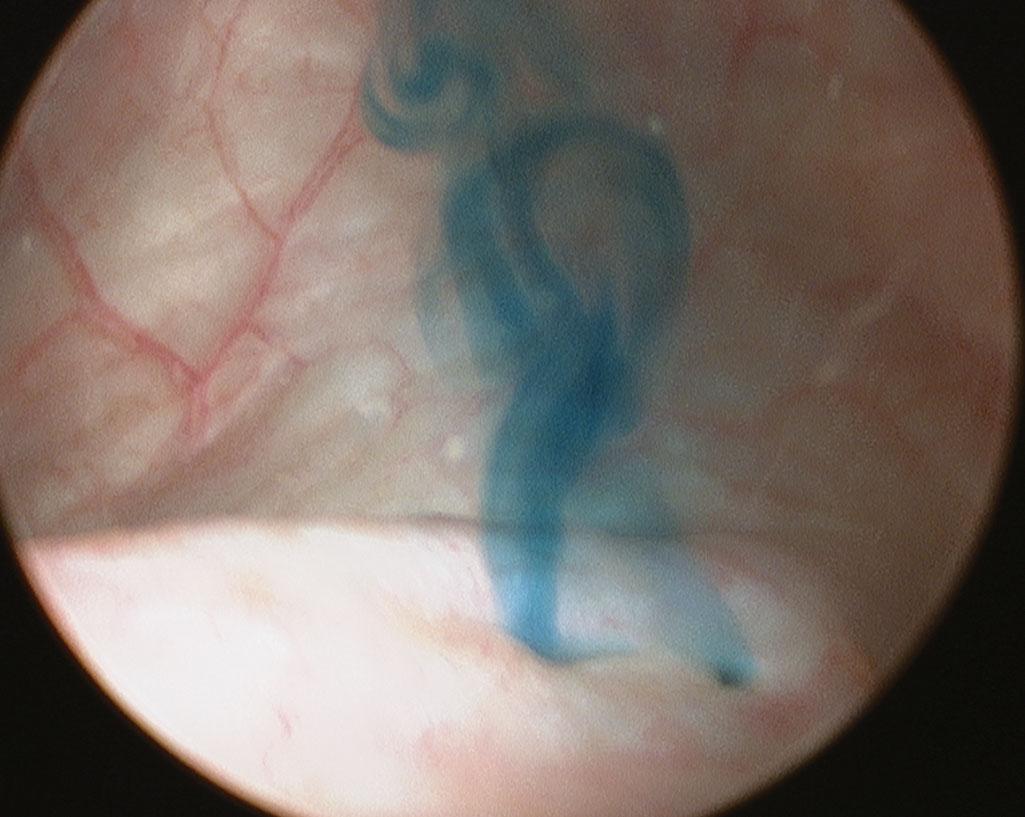
Normal—squamous metaplasia in trigone (benign overgrowth)
Abnormal—hypervascularity
Abnormal—cystic lesions in the trigone; could be benign cystitis (UTI)
Abnormal—stitch or mesh from incontinence surgery
Abnormal—bladder stone or kidney stone that has passed
Abnormal—lesion growing from wall; biopsy, could be carcinoma
Abnormal—grapelike clusters; biopsy, could be transitional cell carcinoma
Abnormal—trabeculations (hypertrophied detrusor muscle), benign; seen in OAB or outlet obstruction
Abnormal—Hunner ulcer; pathognomonic for interstitial cystitis
Abnormal—fronds or pseudopolyps, benign response to inflammation
Abnormal—stricture; prior surgery, especially urethral diverticulum excision
Abnormal—sluggish flow, could mean partial obstruction
Abnormal—no flow, could mean obstruction from current or past surgery, stone, or stricture
Although the term urinary tract infection formally includes both upper tract (i.e., pyelonephritis) and lower urinary tract infections, it is most commonly used for bacterial infections of the bladder and will be used in this section to refer to only bacterial infections of the bladder. Other commonly used terms are acute, uncomplicated cystitis (AUC) and acute bacterial cystitis. UTI is the most common bacterial infection seen in an outpatient setting. As many as 50% of all women develop UTIs at some time during their life and, by age 70, as many as 10% of women will have recurrent UTIs. About 40% of all nosocomial infections are UTI’s and usually related to urinary catheters. Lower urinary tract infections are almost always associated with some combination of the following: frequency, urgency, dysuria, suprapubic pain, pyuria, and hematuria. Dysuria is a highly specific symptom with more than 90% accuracy for UTI in young women without vaginal discharge and irritation and no risk of sexually transmitted infection. Symptoms of flank pain, rigors, nausea and vomiting, and fever should raise concern for pyelonephritis. In older women, symptoms of UTI may be less clear. At times, urinary incontinence is associated with acute and recurrent infections. Although Escherichia coli is the cause of most UTIs (80% to 85%), myriad organisms, including Staphylococcus saprophyticus (5% to 15%), Enterobacter, Klebsiella, Pseudomonas, Proteus, Streptococcus faecalis, Enterococcus, and Chlamydia, can be found.
The presence of bacteria in the urine (bacteriuria) does not necessarily prove clinical infection. Bacteriuria is fairly common in women, especially older women. Asymptomatic bacteriuria is defined as organisms present in the urine that are not causing symptoms or illness. Cumulative data from several studies have suggested that 20% of women older than 65 years will demonstrate bacteriuria, but the percentage increases from approximately 15% in the 65- to 70-year group to 20% to 50% for women older than 80 years. Bacteriuria is present in women who perform chronic catheterization and common in women in nursing homes who are chronically incontinent. Treatment for asymptomatic bacteriuria is not recommended, even in older women or people with diabetes, with no change in their morbidity or mortality ( ). Exceptions exist to this recommendation if the woman is undergoing an invasive genitourinary procedure, is pregnant, has a renal transplant, or is incontinent and her incontinence resolves with treatment. If a woman with asymptomatic bacteriuria becomes symptomatic, treatment is appropriate.
Many explanations have been offered as to why the female urinary tract is vulnerable to infection:
Short female urethra, allowing easier access of bacteria to the bladder
Proximity of the vulva, vagina, and rectum to the opening of the urethra
Effects of sexual intercourse, with increased inoculation
Contraception (e.g., spermicide)
Effects of estrogen loss on the genitourinary tract of older women
After menopause, the vaginal pH rises and may alter vaginal flora, allowing for the loss of the protective species Lactobacillus crispatus and the colonization of uropathogenic species, especially E. coli. Estrogen also affects the maturation of the urethral and trigone mucosa, which can play a role in limiting bacterial infection. Genetic and immunologic factors (e.g., nonsecretors of certain blood group antigens are at increased UTI risk) also play a role in UTI susceptibility, but these are not specific to women.
The definition of a symptomatic UTI is a woman with dysuria, frequency, urgency, or suprapubic pain with pyuria. Uncomplicated UTIs occur in healthy women with normal urinary tract function. UTIs are classified as complicated when there are comorbid conditions with factors that increase colonization and that may require longer treatment courses:
Underlying urologic abnormalities
Presence of a foreign body (e.g., catheter), urinary calculi
Obstruction of urine flow
Diabetes mellitus
Spinal cord injury (neurogenic bladder)
Pregnancy
Renal transplantation or other immunocompromise
Multidrug-resistant bacteria
UTIs can often be diagnosed successfully with symptom assessment. In outpatient settings, women with at least two of three acute symptoms (dysuria, urgency, frequency) in the absence of vaginal discharge (or risk for sexually transmitted infection) have a greater than 90% probability of having AUC. Additional urine testing does not aid in the diagnostic accuracy; however, outside of those criteria, a clean-catch midstream urine sample for chemical analysis (dipstick) testing for leukocyte esterase and nitrites or a microscopic unspun urine evaluation for white blood cells (pyuria) can be helpful. Pyuria should always be seen in the urine when UTI is present. Leukocyte esterase means there are white blood cells (WBCs) present and has a roughly 75% to 80% specificity and 85% sensitivity for UTI. Nitrites indicate that certain gram-negative bacteria have converted nitrate to nitrite and is highly specific but not sensitive because it only occurs with gram-negative bacteria present. Urine microscopy with pyuria (>10 WBC/high-power field [HPF] on spun specimen) is a very sensitive test (95%) but less specific for UTI. Hematuria, microscopic or gross, is common in acute infections, and infection is the most common cause of hematuria. Gross hematuria does not indicate a more severe infection but rather a more significant host response. If hematuria persists after UTI treatment (microscopic after 6 to 8 weeks), it should be evaluated. A contaminated specimen comes from organisms or cells collected while obtaining the clean catch urine. More than 15 to 20 squamous epithelial cells/HPF suggests contamination and a sterile straight catheterization for a urine specimen might be needed.
The pathogens are predictable in AUC, so culture is generally unnecessary and can be reserved for recurrent UTIs (two or more episodes in 6 months or three in a year) and complicated UTIs or when patients are at risk for multidrug-resistant bacterial infection such as a patient who has recently been hospitalized or institutionalized. When a urine culture is done, to be considered consistent with infection, or positive, a single uropathogenic organism grows. The number of organisms per milliliter is not important.
The American Urogynecologic Society (AUGS) and the American Urological Association (AUA) have developed evidence-based guidelines for the treatment of acute uncomplicated cystitis (AUC) and should be routinely referenced for appropriate antibiotic management in light of developing bacterial resistance. Following are current recommendations for empiric treatment of AUC-UTIs in nonpregnant, premenopausal women without pyelonephritis:
Nitrofurantoin monohydrate/macrocrystals twice a day for 5 days (resistance rates of E. coli to nitrofurantoin have remained low).
Trimethoprim-sulfamethoxazole (TMP-SMX) double strength, twice a day for 3-day therapy (if local E. coli bacterial resistance rates are less than 20%). Short-course (3-day) therapy improves patient tolerability and compliance. This treatment strategy results in more than a 90% cure rate.
Fosfomycin trometamol, 3 g given as a single dose. This may have slightly lower efficacy than the other two options.
Fluoroquinolones, although highly efficacious, should be avoided in AUC because resistance is rising and more concerning side effects have occurred. The Food and Drug Administration (FDA) has issued several updates on safety labeling changes, including risk of tendonitis and tendon rupture, mental health side effects, serious blood sugar disturbances (hypoglycemia), aortic dissections, and aortic aneurysm rupture. It is recommended that these medications be reserved for more serious infections. Because of high resistance and relatively poor efficacy, amoxicillin and ampicillin should not be used for empiric treatment. Progression from cystitis to pyelonephritis is uncommon. Cystitis patients should remain adequately hydrated and be encouraged to complete antibiotics, even though symptoms generally disappear within 48 hours. Infections can recur because they are not adequately eradicated. This may result from physician error (treating with too low a dose of antibiotic, the wrong antibiotic, or for too short a period), patient error (not taking the medication as prescribed), or undiagnosed complicating factors and may require imaging, cystoscopy, or other further investigation for bacterial nidus. These patients who relapse (the same pathogen within 2 weeks of an appropriate course of antibiotics) are differentiated from patients with recurrent UTIs (a subsequent UTI occurred beyond the initial 2 weeks or with a different pathogen). For complicated UTIs, urine culture should be done. A 7- to 14-day course of an antibiotic is recommended, and often TMP-SMX double strength, fluoroquinolones, and sometimes a one-time intravenous (IV) antibiotic to initiate treatment (ceftriaxone, aminoglycoside, or fluoroquinolones). When urine culture and sensitivity results return, the antibiotic may be changed if the organisms noted are not sensitive to the antibiotic in use.
Thirty percent to 40% of women will have a recurrent UTI after a single UTI; 50% of these women will have a third episode if they have had two UTIs in 6 months ( ). Women with recurrent UTIs (rUTI), defined as three or more UTIs in a year or two or more UTIs in 6 months, do not generally need routine radiographic imaging—seeking structural abnormalities of the bladder, kidney, or ureters—for it is rarely useful in otherwise healthy women. More than 90% of recurrences in young women are exogenous reinfection with new isolates arising from local flora.
There are several strategies for managing recurrent UTIs ( Fig. 21.10 ). Behavioral modification has become popular for preventing rUTIs. Recommended modifications in lifestyle include increasing water intake in premenopausal women ( ), which dropped rUTIs about 50%. Another strategy is eliminating risk factors, such as discontinuing use of spermicide for contraception; use of nonoxynol-9 has been associated with an increased risk of UTIs in women ( ). Correcting vaginal atrophy in postmenopausal women with rUTIs is often successful. Vaginal estrogen therapy restores the acidic environment of the vagina and protective microbiome ( ).
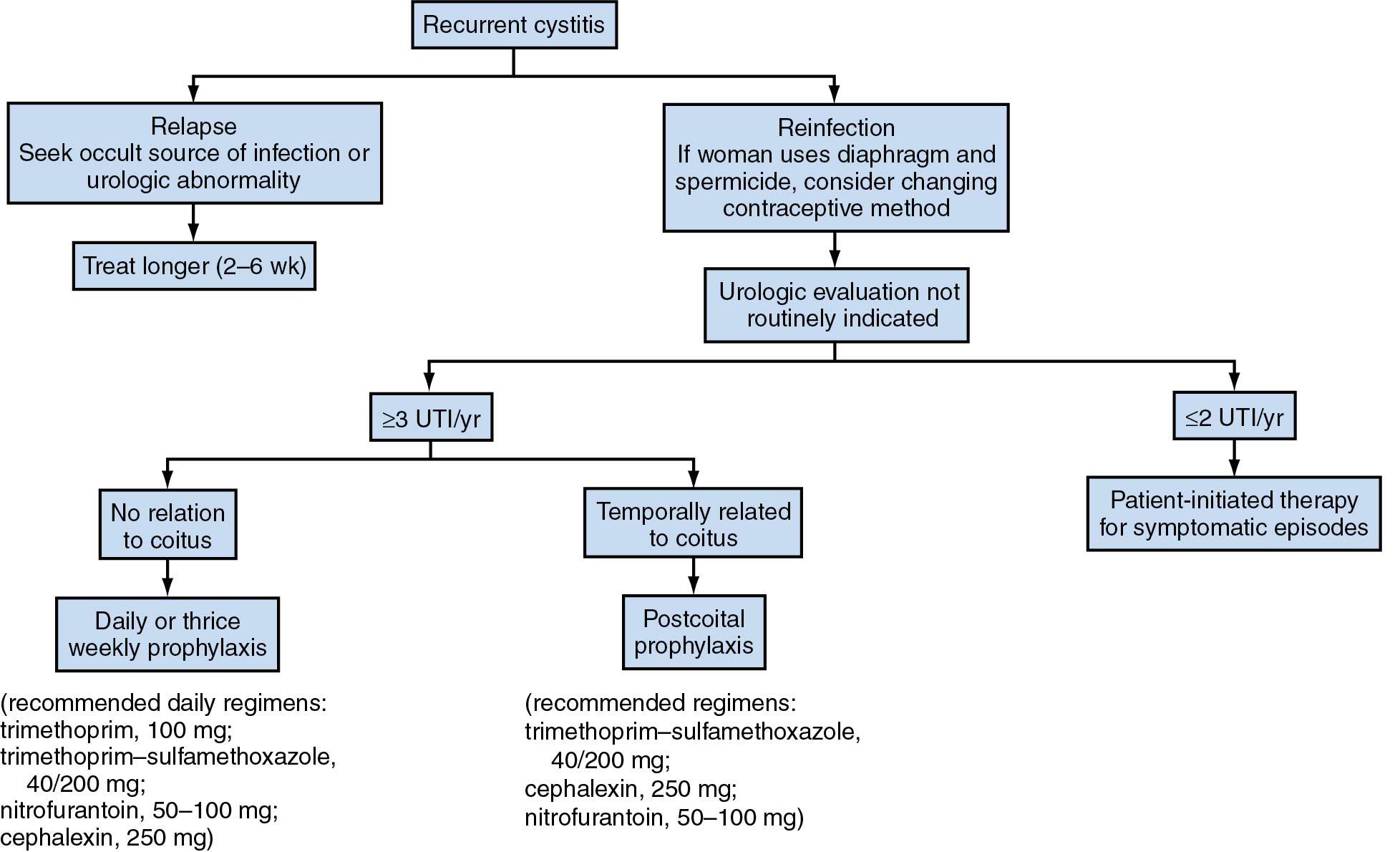
There are other nonantibiotic prevention strategies, such as cranberry supplements, vitamin C, probiotics, D-mannose, and methenamine salts. Strong evidence of benefit is lacking for these options, but some women wish to try these instead of antibiotics. Most evidence exists for cranberry supplements, but the correct dosage and formulation is unknown, studies are contradictory and not conclusive. Cranberries seem biologically plausible, with the active ingredient being proanthocyanidins (PACs), which is thought to prevent binding of E. coli to urothelial cells. Women can try a cranberry supplement, but evidence is less effective than previously thought when 14 more studies were added to the Cochrane review. There is some evidence in a 2012 Cochrane review supporting methenamine hippurate for short-term use (1 week or less). It is metabolized via the production of formaldehyde from hexamine in acidic urine and is bacteriostatic. This does not induce resistance and has minimal side effects. Delaying treatment with antibiotics and trying ibuprofen and increased water has been studied, but it increased the duration of symptoms; furthermore, the majority of women needed antibiotics ( ). Oral probiotics have not shown clinical efficacy in randomized trials. Vaginal delivery of Lactobacillus crispatus may be a more promising strategy, but at present, routine use is not recommended. D-mannose is a natural sugar, thought to bind competitively to bacteria to decrease bacteria attaching to urothelial receptors. The clinical research is scant, but again, some women wish to try nonantibiotics strategies for rUTIs. Vitamin C to acidify the urine has limited data to recommend.
Many episodes of recurrent UTIs in young women occur within 24 hours of coitus. Although eliminating coitus is an option, it is not a widely accepted one. These women are excellent candidates to be treated with postcoital single-dose prophylactic antibiotics. The antibiotics most commonly chosen for low-dose antibiotic prophylaxis include TMP-SMX single strength, nitrofurantoin (50 to 100 mg), and cephalexin (125 to 250 mg).
Often women with recurrent UTIs at unpredictable times prefer self-initiated treatment with the onset of symptoms. Clinicians must document positive urine cultures associates with prior symptomatic episodes before ordering self-initiated treatment antibiotics. Using the antibiotics presented earlier for uncomplicated UTI is reasonable. Continuous prophylactic antibiotics are needed in some situations. Continuous daily prophylaxis is considerably more effective than other options but may increase the risk of bacterial resistance and drug complications. Daily prophylaxis regimens have been reported up to 5 years; however, it is rarely continued beyond 6 months. Evaluation for efficacy and side effects is reasonable at 3 months.
In summary, recommendations for rUTI management as outlined in the American Urogynecologic Society (AUGS) best practice statement include the following ( ):
Diagnosis:
Urine culture should be performed before initiating antibiotic therapy.
Urine culture after therapy may help define a distinct episode.
Antibiotic choice:
Nitrofurantoin is a key first-line agent (50 to 100 mg daily).
Fosfomycin is effective (3 g every 10 days) but sensitivity testing may be needed.
TMP-SMX can also be used if resistance is less than 20% in the community.
Fluoroquinolones are not a first-line treatment of acute cystitis without complicating factors.
Prevention:
Postcoital antibiotic suppression is effective in women with coitally related rUTI.
Low-dose daily antibiotic suppression (3 to 6 months) is effective in women with noncoitally related rUTI.
Effective nonantibiotic measures are cessation of spermicides, vaginal estrogen in atrophic women, and methenamine.
Although the focus of this section was UTIs in patients with no complicating factors, there are gynecologic reasons for some women to present with complicated UTIs. These include the presence of an indwelling Foley catheter or need for clean intermittent catheterization after gynecologic surgery, pregnancy and physiologic hydronephrosis of pregnancy, pelvic prolapse with incomplete bladder emptying, urethral diverticulum or obstructed Skene gland, and eroded mesh or suture creating a bladder foreign body and stones. An indwelling catheter for 24 hours leads to bacteriuria in as many as 50% of patients. When left in place for 96 hours, an indwelling catheter causes bacteriuria in almost 100% of patients. There is no good evidence supporting the use of prophylactic antibiotics in patients who must continue catheter use. A woman with an indwelling catheter should be monitored for the possibility of a symptomatic UTI, be kept adequately hydrated, have a urine culture if symptoms occur, and be treated with the appropriate antibiotic; however, it is difficult to eradicate infection in the presence of an indwelling catheter. Removing the catheter or switching to clean intermittent self-catheterization is optimal if possible. Postoperative and debilitated patients are at greatest risk.
UTI with hydronephrosis in pregnancy may require improved drainage with ureteral stent or nephrostomy tube. Patients with prolapse and a UTI and incomplete bladder emptying may require urethral catheter drainage and ultimately prolapse reduction with pessary or surgery. Patients with a urethral diverticulum may need surgical repair, and patients with eroded mesh or suture with stone formation need surgical correction as well. Being aware of these complicating factors in patients with UTIs allows appropriate and timely care of these complicated patients.
Bladder pain syndrome, originally called interstitial cystitis (IC/BPS), is a poorly understood chronic pain syndrome of unknown cause characterized by genitourinary pain and voiding symptoms. IC/BPS is a clinical diagnosis—one of exclusion. Once thought of primarily as a disease of the bladder and of women, IC/BPS and its association with other chronic pain syndromes suggest that its cause in at least a subset of patients extends well beyond the bladder. The prevalence in men has approached that of women in some studies (Suskind, 2013). The diagnosis of IC/BPS should be considered in patients with chronic pelvic pain.
Become a Clinical Tree membership for Full access and enjoy Unlimited articles
If you are a member. Log in here